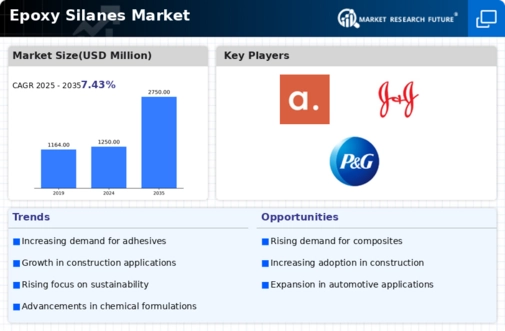Top Industry Leaders in the Epoxy Silanes Market
 The epoxy silanes market, though a niche within the specialty chemicals industry, pulsates with intense competition and constant innovation. These vital coupling agents, bridging the gap between inorganic materials and epoxy resins, are the workhorses powering diverse applications like adhesives, sealants, composites, and electronics. Understanding the competitive landscape of this dynamic market requires a deep dive into its key players, their strategies, and the factors influencing market share.
The epoxy silanes market, though a niche within the specialty chemicals industry, pulsates with intense competition and constant innovation. These vital coupling agents, bridging the gap between inorganic materials and epoxy resins, are the workhorses powering diverse applications like adhesives, sealants, composites, and electronics. Understanding the competitive landscape of this dynamic market requires a deep dive into its key players, their strategies, and the factors influencing market share.
Market Leaders and Strategies:
Several established players dominate the epoxy silanes market, each employing unique strategies to stay ahead. Evonik Industries remains the global leader, leveraging its robust R&D infrastructure and extensive product portfolio catering to various end-use applications. Shin-Etsu Chemical Co. Ltd. follows closely, focusing on high-purity silanes and customized solutions for niche markets. Momentive Performance Materials, with its strong presence in electronics and composites, adopts a value-driven approach, emphasizing technical support and application expertise. Dow Chemical and Hexion Inc. complete the top five, with Dow capitalizing on its global reach and production capacity, while Hexion emphasizes cost-effectiveness and strategic acquisitions.
Factors Shaping Market Share:
Beyond brand recognition, several factors influence market share in the epoxy silanes market:
-
Product Innovation: Developing novel silanes with improved performance or addressing specific application needs fosters customer loyalty and market differentiation. Recent examples include Momentive's Silquest* A-Link 4955 for improved adhesion in electronics and Evonik's TEGO Si 240 for enhanced flame retardancy in composites. -
Regional Focus: Understanding and catering to regional market dynamics is crucial. Asia Pacific, fueled by rapid industrialization, exhibits the highest growth potential, attracting significant investments from players like Dow and Shin-Etsu. -
Sustainability Initiatives: The emphasis on eco-friendly solutions opens doors for manufacturers offering bio-based or readily recyclable silanes. Evonik's TEGO Si 2350, a bio-based silane for adhesives, exemplifies this trend. -
Vertical Integration: Integrating backward to secure raw materials or forward into downstream applications can offer cost advantages and market control. Shin-Etsu's vertically integrated silane production is a prime example.
Key Players Some of the leading players in the global epoxy silanes market are Evonik Industry AG (Germany), Dow (US), Mitsubishi Corporation (Japan), BGF Industries, Inc. (US), ChemSpec (US), Qufu Chenguang Chemical Co., Ltd (China), Nanjing Union Silicon Chemical Co., Ltd (US), Dalian Resourcea Co., Ltd (China), and SiSiB Silicones (China).
Recent Developments:
-
October 2023: Innovation flourishes with Shin-Etsu's next-generation silane for high-temperature applications and Momentive's development of silanes for 3D printing. -
November 2023: Regulatory concerns emerge with stricter environmental regulations in Europe impacting raw material sourcing for some players. -
December 2023: Industry collaboration takes center stage with a consortium formed to develop standardized testing methods for epoxy silanes.

